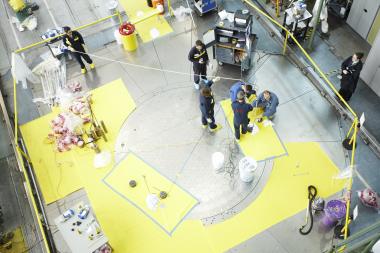Positive signs in isotope production
09 October 2009
Atomic Energy of Canada Ltd (AECL) now knows the full extent of repairs required to the NRU reactor tank and has the tool to carry out the job. Meanwhile, a decision in principle on a new reactor has been made in the Netherlands.
 |
Workers during the inspection of NRU
(Image: AECL) |
The National Research Universal (NRU) unit at Chalk River has been producing the major share of the world's medical isotopes for some 50 years, but sprung a minor leak of heavy water from its tank in May. Repairing the leak, a simple result of corrosion over the years, has so far required the draining of the tank, removal of all NRU's fuel and a lengthy remote inspection.
AECL said in its latest update that just six areas of the inside base of the reactor vessel wall require localised repair and a special tool has been made for this purpose. AECL staff are now being trained to take on the job by the unnamed company which made the custom device, and the band weld build-up technique to be used is being qualified by the Technical Standards and Safety Authority.
AECL said that it was still on track to return NRU to service in the first quarter of 2010, but a worldwide shortage of medical isotopes continues. In addition to NRU's outage, the world's second-biggest medical isotope producer is also in need of repair. The High-Flux Reactor (HFR) at Petten in the Netherlands has deformations in part of its primary cooling system that are allowing the ingress of tiny bubbles.
Dutch nuclear safety regulators granted an extraordinary licence for owner-operator NRG to operate HFR until March 2010, but at that point it is slated to undergo a difficult repair lasting up to three months. In addition, France's Osiris reactor is set for maintenance in 2010 and final shutdown in 2015 with NRU following it one year later.
Major new reactor on the way
One initiative that promises to relieve the situation in the long term is the Pallas reactor proposed for the Netherlands. A statement from government today backed the idea, and a letter in support was sent from the cabinet to parliament.
Three ministers, between them covering science, technology, planning, education, the environment and the economy wrote to give a positive decision in principle on the construction of Pallas, which they noted would provide 500 high-quality direct jobs as well as 1000 more indirect roles.
NRG told World Nuclear News that it had been waiting for such a positive statement, and that it anticipates starting the licensing procedure for the new reactor "within weeks", based on a current conceptual design. "By the end of this year" a contractor should be chosen to start a two-year project to produce a detailed design. In 2012, NRG said, full licensing deliberations would be underway based on the detailed design and a proposed site, which would either be Petten, where HFR stands, or in the locality of the country's nuclear power plant, Borssele, where there is strong local government support.
According to NRG's current thinking, Pallas could be built around 2014 or 2015 and enter full operation during 2016. The Univesity of Saskatchewan in Canada has also tabled a proposal to government for a new isotope production unit to begin operation around the same time.